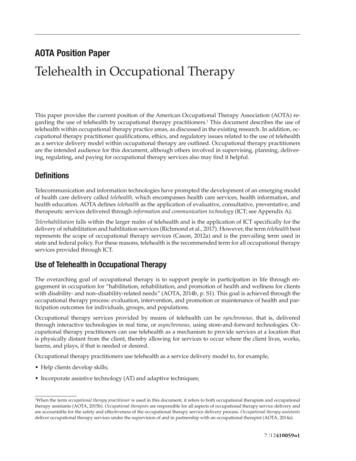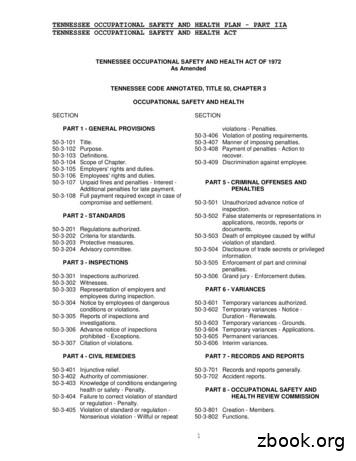Case Studies - Occupational Safety And Health Administration
Case StudiesThese case studies present situation resulting in injury or death. Read the case studies assignedto your group and then respond to the questions below. Be prepared to discuss your responseswith other class participants.1. What was the primary cause of these incidents?2. What steps can you suggest to control the hazards?3. What would you do now that is different from what you would have done before taking thetraining?NJ State AFL-CIO: Case StudiesPage 1 of 6
Case Study #1 – Amputation in Meat GrinderA 15-year-old part-time worker (the victim) at a retail grocery store suffered amputation of theright arm as a result of being caught by the auger of a meat grinder while he was reassembling it.The victim, working after school, had completed washing and cleaning the disassembled parts ofthe grinder and was reassembling it without de-energizing and locking out the machine's powersupply (See Photos Below). He inserted the auger into the grinder's housing and reached throughthe feed-throat with his right hand to guide it into engagement. As he did so, he bumped againstthe unprotected on/off lever switch mounted about waist high on the machine's side. The grinderstarted and the auger pulled his hand and arm into the housing. He turned the machine off, pulledhis arm from the grinder housing and ran toward the front of the store. The store manager appliedpressure to his bleeding arm while a coworker called 911. The victim was transported to a localhospital. His right arm had been amputated just below the elbow. A magnetic safety switchmounted on top of the motor starter was designed to prevent operation when the Removable Tubwas taken off. The safety switch had not worked for over 16 years and employees were notaware that the safety switch existed. (Source: tml)NJ State AFL-CIO: Case StudiesPage 2 of 6
Case Study #2 – Fatality by Dough Mixing MachineA 15-year-old male pizzeria worker was killed when he became entangled in a machine used tomix pizza dough (see photos below). The victim had arrived in the United States from Guatemalaone month before the incident and had been working at the family-owned pizza restaurant fortwo weeks. He was paid to do odd jobs at the restaurant, mostly sweeping and cleaning. On thenight of the incident, he was cleaning the pizza dough mixer as the restaurant was closing for theevening. He was working alone in the kitchen as the remaining staff cleaned the adjoining diningroom. He apparently lifted the cover of the mixer, uncovering the 32-inch-diameter mixing bowl,and started the machine. As he reached in to the bowl to clean it, he became entangled on a largemixing fork (beater) that rotated inside the mixing bowl. His co-workers heard him scream, butwere unable to reach him in time. The mixer cover was equipped with a safety interlockactivated by a pin pressed by the hinge of the cover. On this mixer, the weight of the open coverflexed the hinge enough to disengage the interlock, allowing the machine to activate with thecover open. (Source: .html)NJ State AFL-CIO: Case StudiesPage 3 of 6
Case Study #3 – Fatality by Baling MachineA 16-year-old male produce-market worker (the victim) died from crushing injuries after beingcaught in the vertical downstroke baling machine that he was operating (see picture below). Thevictim, working alone in the basement of a small produce market, was crushing cardboard boxeswhen at some point in the compacting process he was caught by the machine's hydraulic ram.The victim was discovered by an exterminator spraying the basement, who notified the storemanager to call police and emergency medical services (EMS).Subsequent examination by investigators revealed that the safety interlock had been bypassed,allowing the machine to operate with the loading door in the open position. The victim may havereached into the baling chamber during a compression cycle to adjust a tie wire or a liner box andwas caught by the ram platen. (Source: tml)NJ State AFL-CIO: Case StudiesPage 4 of 6
Case Study #4 – Drill Press FatalityA 57-year-old male supervisor/drill press operator (victim) was fatally injured after hisshirtsleeve was caught by the rotating drill bit of the drill press he was operating. The rotatingbit tightened the shirt around his neck, strangling him. The victim, working alone, was clampingeight-inch by eight-inch by half-inch thick steel plates to the drill press table while the drill bitwas rotating. A co-worker was passing by and noticed the victim caught in the running drillpress. The co-worker shut off the drill press as another co-worker arrived to help. Both coworkers were trying to hold up the victim while a third co-worker went to call for emergencyassistance. The victim was transported to a hospital in a neighboring state where he waspronounced dead. (Source: .html)NJ State AFL-CIO: Case StudiesPage 5 of 6
Case Study #5 – Conveyor Belt FatalityAn 18-year-old male (the victim) died when his right arm became caught in the roller mechanismunderneath a conveyor belt. He was pulled into the roller mechanism and suffered compressionalasphyxia and blunt force injuries. The employer was a corporation that manufactured hardwoodtrim, stairways, doors, mantels and moldings. The victim had worked for the employer twomonths in the cutting room as a chop saw operator. His job was to chop out knots and otherimperfections, to cut rough lumber to the desired lengths, and to clean up scrap wood by loadingit onto the flat portion of the conveyor, which ran the length of the building.On the day of the incident, the victim began his 10-hour shift at 4:30 p.m. He had been workingapproximately seven and a half hours when the incident occurred. His work station wasapproximately 150 feet away from the portion of the conveyor involved in the incident, but hehad left his work station because he was caught up. After 5-10 minutes had elapsed, hissupervisor began to look for him.The supervisor finally located the victim, entangled in the inclined portion of the conveyor belt.The victim's right arm, up to the shoulder, had been pulled into the roller mechanism underneaththe belt at a point where the bottom of the roller was almost six feet above the floor (see Figurebelow). The supervisor, upon seeing the victim, immediately shut off power to the belt at a wallpanel four feet beyond where the victim was entangled.Since there were no eyewitnesses to this incident, it is not certain how the victim became caught.The roller mechanisms were too high to have caught him or his clothing (sleeveless shirt, jeans)as he walked by unless he jumped up or reached up. The victim was not wearing any gloves orother personal protective equipment (PPE). The conveyor belt was in constant operation whenthe plant was running so workers throughout the plant could place scraps on it at any time. It ispossible that the victim might have been climbing up the conveyor belt and may have caught hishand in the roller from above. Coworkers reported having seen the victim riding the raisedportion of the belt on previous occasions, and he had received written reprimands for this. It isalso possible that he reached up as he was walking under the belt, catching his hand between therollers. (Source: .html)NJ State AFL-CIO: Case StudiesPage 6 of 6
NJ State AFL-CIO: Case Studies Page 1 of 6 Case Studies These case studies present situation resulting in injury or death. Read the case studies assigned to your group and then respond to the questions below. Be prepared to discuss your responses with other class participants. 1. What was the primary cause of these incidents? 2.
series b, 580c. case farm tractor manuals - tractor repair, service and case 530 ck backhoe & loader only case 530 ck, case 530 forklift attachment only, const king case 531 ag case 535 ag case 540 case 540 ag case 540, 540c ag case 540c ag case 541 case 541 ag case 541c ag case 545 ag case 570 case 570 ag case 570 agas, case
1When the term occupational therapy practitioner is used in this document, it refers to both occupational therapists and occupational therapy assistants (AOTA, 2015b). Occupational therapists are responsible for all aspects of occupational therapy service delivery and are accountable for the safety and effectiveness of the occupational therapy .
This Occupational Safety and Health Manual implements one of the elements of the National Weather Service (NWS) Occupational Safety and Health Program defined in NWS Policy Directive NWSPD-50-11, Occupational Safety and Health. The manual includes 32 safety procedures developed in accordance with Occupational Safety and Health Administration
Documentation of occupational therapy services is necessary whenever professional services are provided to a client. Occupational therapists and occupational therapy assistants1 determine the appropriate type of documentation structure and then record the services provided within their scope of practice. This document, based on the Occupational .File Size: 540KBPage Count: 9Explore furtherDocumentation & Reimbursement - AOTAwww.aota.orgNEW OT Evaluation and Reevaluation - AOTA Guidelinestherapylog.typepad.comWriting progress notes in occupational therapy jobs .www.aureusmedical.comDocumentation & Data Collection For Pediatric Occupational .www.toolstogrowot.comSOAP Note and Documentation Templates & Examples Seniors .seniorsflourish.comRecommended to you b
Occupational therapists around the world are obligated to promote occupational rights as the actualization of human rights. This obligation requires addressing occupational injustices, initially named as occupational deprivation, occupational imbalance, occupational marginalisation, and occupational alienation (Wilcock & Townsend, 2000 .
tennessee occupational safety and health plan - part iia tennessee occupational safety and health act 1 tennessee occupational safety and health act of 1972 as amended tennessee code annotated, title 50, chapter 3 occupational safety and health section part 1 - general provisions 50-3-101 title. 50-3-102 purpose. 50-3-103 definitions.
403-1 Occupational health and safety management system 403-2 Hazard identification, risk assessment, and incident investigation 403-3 Occupational health services 403-4 Worker participation, consultation, and communication on occupational health and safety 403-5 Worker training on occupational health and safety 403-6 Promotion of worker health
2.14. P ercent of Occupational NYS OHCN Patients, by Major Occupational Group and Patient Type .21 2.15. Percent of Occupational NYS OHCN Patients, by Major Occupational Group and Geographic Region .22 2.16. P ercent of Occupational NYS OHCN Patients,























